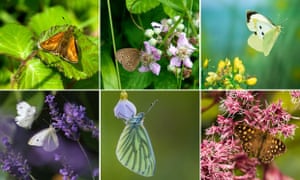Severe droughts caused by global warming could have a far greater impact on some UK species of butterfly than previously thought

Continuing climate change caused by carbon emissions from power stations and vehicles is set to have catastrophic consequences for British butterflies including currently widespread species such as the cabbage white and large skipper.
Researchers have found that the increase in extreme droughts as global warming takes hold will cause six species of UK butterflies to be lost from several areas of the country as soon as mid-century.
Previous studies have looked at what a gradual increase in temperatures means for British wildlife, but a new paper published on Monday in the journal Nature Climate Change examined the impact of more extreme heat events. It found that butterflies which were predicted to do well under gradual warming would in fact be badly-hit by an increase in severe droughts.
Looking at how butterflies fared in the 1995 drought, the most arid summer since records began in 1776, the researchers identified six species that were particularly sensitive to drought – and then examined how often they would be struck by similar droughts in the future because of climate change.
“On average across the whole country it is quite bleak. I was surprised looking at climate data by the rapid increase in frequency of droughts we are in for,” said Tom Oliver, the paper’s lead author and an ecological modeller at the UK Centre for Ecology and Hydrology.
“Historically that 1995 drought was once in 200 years. And yet even on the low emissions scenario, by 2050 that’s happening every seven years. Under the high emissions scenario [what we are currently on track for] it’s every year.”
However, he said that there would be cooler, wetter refuges in the UK, such as the north-west of England and Scotland where some of the six species – cabbage white (Pieris brassicae), small cabbage white (Pieris rapae), ringlet (Aphantopus hyperantus), green-veined white (Pieris napi), speckled wood (Pararge aegeria), and large skipper (Ochlodes sylvanus) – would survive.
Advertisement
Oliver said the way the species were identified as sensitive to drought was conservative, and that it was unlikely that it would just be butterflies that were hit. “It’s likely other species besides butterflies will be affected by drought. Because butterflies are a well-studied group they can be used as an indicator for other groups, a canary in the coal mine, if you will,” he said.
If such losses also applied to other wildlife – such as bees and beetles – that would have a “substantial impact” on our wildlife and an “alarming” impact on the services they provide for ecosystems and agriculture, such as pollination, he said.
The study also highlighted the importance of a good, unfragmented landscape for butterflies hit by increasingly frequent droughts. “If a local population does go extinct it can potentially be recolonised from elsewhere, but they have to be able to move through the landscape. If there is hostile landscape in the way, they might not be able to,” said Oliver.
That finding made a strong case for making the woodlands, grasslands and heathlands where Britain’s about 50 species of butterflies feed and breed more joined-up, he said. “We are still waiting for action at sufficient scale [on habitats],” Oliver said.
But under a business-as-usual scenario for warming – which assumes little or no international action is taken on climate change – even massively improving the landscape would not stop widespread local extinctions by the end of the century.
The only way to guarantee the butterflies’ survival by 2100 would be dramatic carbon cuts far beyond what governments have proposed so far, and “significant reductions in habitat fragmentation”.
It was unlikely that the butterflies would evolve quickly enough to adapt to the droughts, the study concluded.
Oliver said he hoped the paper would give another reason for international negotiators meeting in Paris later this year to reach a strong deal on climate change.
“I think every little helps. We’re highlighting the plight of these sensitive species under the marked increase in drought. Hopefully these results add to the pressure for international agreement for action on emissions.”

